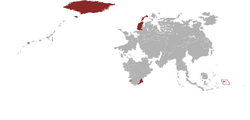Nordic Empire: Difference between revisions
No edit summary |
mNo edit summary |
||
| Line 100: | Line 100: | ||
<!-- Titles and names of the first and last leaders and their deputies --> | <!-- Titles and names of the first and last leaders and their deputies --> | ||
|leader1 = Kristian IV | |leader1 = Kristian IV | ||
|leader2 = | |leader2 = Erik III | ||
|leader3 = | |leader3 = | ||
|leader4 = | |leader4 = | ||
|year_leader1 = 1702–1756 <small>(first)</small> | |year_leader1 = 1702–1756 <small>(first)</small> | ||
|year_leader2 = | |year_leader2 = 1971–''Present'' <small>(last)</small> | ||
|year_leader3 = | |year_leader3 = | ||
|year_leader4 = | |year_leader4 = | ||
| Line 122: | Line 122: | ||
|deputy4 = | |deputy4 = | ||
|year_deputy1 = 1813–1822 <small>(first)</small> | |year_deputy1 = 1813–1822 <small>(first)</small> | ||
|year_deputy2 = | |year_deputy2 = 1967-1978 <small>(last)</small> | ||
|year_deputy3 = | |year_deputy3 = | ||
|year_deputy4 = | |year_deputy4 = | ||
Revision as of 18:26, 20 September 2021
This article is incomplete because it is pending further input from participants, or it is a work-in-progress by one author. Please comment on this article's talk page to share your input, comments and questions. Note: To contribute to this article, you may need to seek help from the author(s) of this page. |
Nordic Empire Nordisk Imperium | |
|---|---|
| 1702–1975 | |
 The Nordic colonial empire at its greatest territorial extent in 1917 | |
| Status | Colonial empire |
| Capital | Kristianshavn |
| Common languages | Dalish (official) |
| Religion | Nordic Semitarism |
| Government | Constitutional monarchy |
| King | |
• 1702–1756 (first) | Kristian IV |
• 1971–Present (last) | Erik III |
| Chancellor | |
• 1813–1822 (first) | Albert of Hartved |
• 1967-1978 (last) | Erland Laursen |
| History | |
• Established | 1702 |
• Dissolution of Oriental Charter | 1814 |
• Conquest of New Eyland | 1862 |
• Incorporation of Nokamba | 1889 |
• Treaty of Kristianshavn | 1969 |
• Disestablished | 1975 |
The Nordic Empire (Dalish: Nordisk Imperium), also known as the Nordic colonial empire (Nordisk koloniimperium) refers to the overseas territories and trading posts controlled by the Nordic Kingdom and its associated charter companies, notably the Dalish Oriental Charter and Nordic Colonial Charter, between 1702 and 1965. Originally a network of overseas trading posts and treaty ports, the Nordic Empire evolved into an expansive territorial empire in the latter half of the 19th century, with its territory spanning areas of Alvinia, Caphtora, and Mavronesia.
Nordic colonial efforts can be traced back to the Viking colonisation of Haxland, along with Snaeland and Vesturey between the 9th and 10th century which marked the first true efforts by a Berean civilisation to settle an overseas territory. This was followed in the 16th century as the Købmandslaug trading league sought to establish new trading posts in Alvinia to offset their loss of influence in Berea. Though these settlements were initially established to form trading relationships with the native populations, they soon came to be colonial possessions in the truest sense of the word, with numerous islands playing host to cocoa, coffee, tabacco, and sugar plantations. Nevertheless, the Købmandslaug proved incapable of maintaining control of its possessions, with most islands either succumbing to native revolts or conquest by the Cuthish Empire. By the mid-17th century the Købmandslaug found itself bankrupt, leading its territories to be incorporated into the Dalish Crown.
In response to the decline of the Købmandslaug, the Crown of Dalland established the Dalish Oriental Charter with the aim of building new trading posts within Caphtora, Pamira, and Melasia. The new organisation proved successful at claiming a number of trading posts along the coast of the Caphtoric Ocean, bringing significant financial gains to the Dalish crown. However, many of these territories would eventually be lost in the following centuries as trading rights were revoked or foreign empires captured them. Nevertheless, with the formation of the Nordic Kingdom in 1702, the remaining territories of the DOC in Caphtora and Mavronesia were reorganised into the Nordic Colonial Charter.
Under the NCC, Norden's grip on its overseas holdings was solidified, with the establishment of new fortifications and security treaties with native populations. By the mid-19th century, Norden's colonial ambitions grew significantly, leading the country's colonial administration to abandon the strategy of settling strategically located trading posts in favour of establishing settler colonies and protectorates. This was first realised in 1862 as Norden established the colony of New Eyland, and was followed by the establishment of the Nokonda Protectorate in 1889 via the Treaty of Godhavn. Whilst the new approach solidified Norden's control of key territories, it also led to significantly increased costs for the colonial administration.
By the mid-20th century, Norden's colonial empire entered terminal decline, with colonial uprisings occurring in both New Eyland and Nokonda. With the military bogged down in a decade long struggle in Nokonda, in 1969 Chancellor Erland Laursen announced that Norden would be withdrawing from its embattled territories, granting independence to both. This would eventually be followed in 1975 with the official dissolution of the Empire and the reform of the autonomous administrations of Norden's remaining overseas territories in Snaeland and Vesturey.

